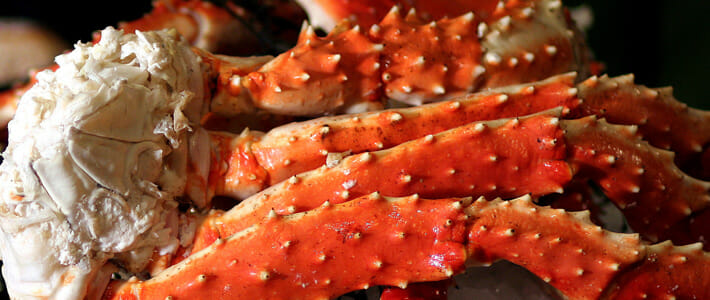Crab, King

The king crab industry is one of the most valuable seafood based industries in the U.S. Species of king crab include red, brown, or golden, and blue king crab. One of the largest species of crab, it ranges in size from 5 to 20 pounds and 6 feet across and has a spiny shell and long, spidery legs (king crab is considered a spider crab.) As opposed to the usual ten legs on a crab, it has eight visible appendages, with its fifth pair of legs very small and tucked into its body. Each side of the king crab has three walking legs and a claw arm with a pincher, one feeder claw, and one killer claw. The meat is creamy white with red coloring.
King crab is available year-round. All king crabs are either brine or blast frozen. Brine will have a longer shelf life and a saltier taste than the blast frozen.
Product pdf for download-
3.5 oz (100g) raw, edible portion
-
Calories 84
-
Calories from Fat 5
-
Total Fat 0.6g
-
Saturated Fat 0g
-
Cholesterol 42mg
-
Sodium 836mg
-
Total Carbohydrates 0g
-
Protein 18.3g
-
Potassium 204mg
Texture
The meat is moist and firm. The claw and leg meat is somewhat firmer than the body meat.
Preparation
King crab is always pre-cooked and can be served either hot or cold. Popular preparation methods include broiling with butter, grilling, sautéing, and steaming. Crab meat is an excellent addition to soups stews, salads and pastas. Remember to thaw crab meat slowing in a refrigerated environment to avoid the meat from becoming mushy.
Quality Control
King crabs, as all crabs, must be cooked live, thus it is important that they be kept alive before being processed. King crabs are often held in tanks of circulating sea water on-board the ships, which can keep them alive for days. Any crab showing no sign of movement is discarded. Once cooked, the crabmeat must be kept refrigerated or frozen. Some crabmeat is pasteurized to prolong shelf life. Pasteurized product should be kept on ice. It is important that all frozen crab is well glazed in order to prevent dehydration.
Alternatives
Some alternatives to king crab are snow crab, dungeness crab, red crab, and lobster.
Source
King crab is found in the cold waters of the North Pacific and the Bering Sea, and to a lesser extent, off the coasts of Chile and Argentina. The largest producer of king crab is Russia, with the US (Alaska) being second.
Harvest Method/Season
King crabs are caught in 800-pound steel traps (pots). Only males meeting minimum requirements (which vary) are harvested. Females and undersized males are thrown back alive. Some crab is processed on-board. Others are kept alive and delivered to floating processors or shore plants. During processing, the crabs are boiled, butchered, and frozen.
Legs (frozen) Cooked legs and claws, red and brown are sized according to sections per 10 lbs. 6-9, 9-12, 12-14, 14-16, 16-20, 20-24, 20 & up. Meat (frozen) Cooked meat, leg and body meat. Packed 6×15 block frozen, vacuum-packed. Clusters/Sections (frozen) Contains ungraded cooked clusters/sections. Packed bulk in totes.
Flavor
King crab’s rich meat has a sweet and succulent flavor.
Market Segments
King crab is appropriate for casual dining, fine dining, hotels, and resort/clubs.